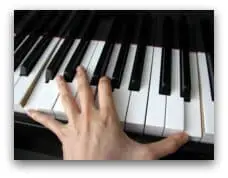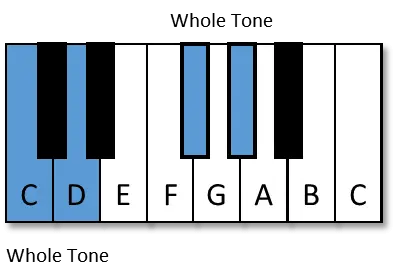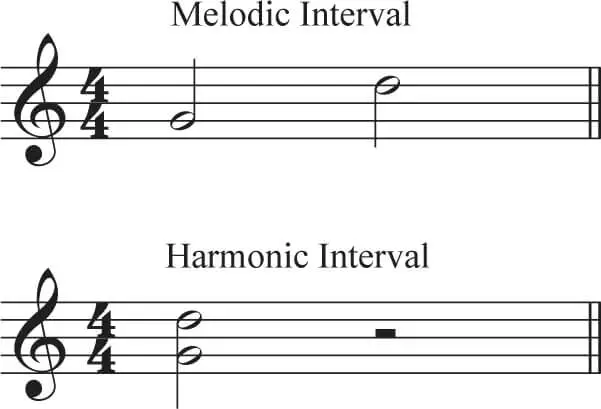- Home
- Basic Piano Theory
- Music Intervals
Learn About Music Intervals and How to Identify Them
This article may contain compensated links. Please read the disclosure for more info.
What are music intervals? An interval in music is simply the distance between a note and the note next to it. Intervals are one of the most important “building blocks” in music. Other important "building blocks" are scales and chords.
Practicing piano intervals and learning to identify them can improve your ability to read sheet music more efficiently and accurately.
By understanding intervals, you can better recognize patterns in music and anticipate the notes that will follow, leading to a more fluid and expressive performance.
Why Music Intervals are Important
 A music interval of a 10th!
A music interval of a 10th!Why do you need to know about intervals?
There are many reasons to learn about intervals. For example:
- Recognizing intervals makes learning to read music and sight-read sheet music easier.
- Understanding intervals also makes it easier to analyze the music and to understand the harmony of a piece.
- And knowing the patterns of the intervals makes it easier even to memorize a piece or understand the make-up of a chord.
The good news is- learning to master intervals is easy, especially for pianists!!!
 Music Interval Numbers
Music Interval Numbers Music intervals are the distances between the notes.
Music intervals are the distances between the notes.Measuring Simple Intervals
Take a look at this keyboard.
- Pick any white key on the piano. That key is one (1). The key next to it is 2, and so on.
- The interval from 1 to 2 is called….. A second!!
- Choose another. For example, from F to A is the interval of 1-2-3...a third!! Yes!

White key music intervals
The white keys on a piano keyboard represent the basic 7 notes in the musical alphabet; A, B, C, D, E, F, G. From one white key to another, you will find all the different basic piano intervals.
The basic intervals are: unisons, seconds, thirds, fourths, fifths, sixths, sevenths, and octaves.
Larger intervals are called compound intervals since they can be seen as an octave plus a second; a ninth, an octave plus a third; a tenth, and so on.
All "White Key" Intervals
Here you can see all the piano intervals on the white keys (no sharps (#) or flats (b) ). See how they look both on the piano keys as well as with music notation:
Unison: From 1 To 1 (One Note To Another Exactly The Same Note):

Second: From 1 To 2

Third: From 1 To 3

Fourth: From 1 To 4

Fifth: From 1 To 5

Sixth: From 1 To 6

Seventh: From 1 To 7

Octave: From 1 To 8 (The Same Note An Octave Higher Or Lower.)

Ninth: From 1 To 9
Tenth: From 1 To 10, Etc.
Learning interval names is easy and can be quickly mastered while playing the piano. Practice by saying the names of the intervals out loud while playing.
Tip: Observe how the odd-numbered music intervals, thirds, fifths, and sevenths have an “even look”; space-space notes or line-line notes.
Whereas the even-numbered intervals, seconds, fourths, sixths, and octaves, have an “odd look”; line-space notes or space-line notes.
This little distinction makes them easier to recognize without counting! :)
Harmonic and Melodic Intervals
The two notes of the music intervals are played either simultaneously, which is called a harmonic interval, or one at a time which is called a melodic interval:

Interval Qualities
Too easy, huh? Ready for a bit of a challenge? OK!
Not all intervals are the same. They don't come only in different sizes but in other "qualities."
We have major, minor, augmented, diminished, and perfect to choose from. No- you can't choose! There are rules:
- Unison, fourths, fifths, and octaves are either perfect*, augmented, or diminished.
- Seconds, thirds, sixths, and sevenths are called either major (big)or minor (small). When using sharps or flats, they can also become augmented (extra big!) or diminished (extra small).
*The term "perfect" comes from a historical tuning system. In this system, intervals that sound especially consonant, such as the unison, octave, perfect fourth, and perfect fifth, are said to be "perfect."
Perfect, Augmented And Diminished Intervals
All Unisons and Octaves are always perfect (if you haven’t altered one of the notes with a sharp or a flat):

All the Fourths on the white keys on the piano keyboard (or notes without sharps or flats) are perfect, EXCEPT between F and B.
The Fourth between F and B is "bigger" than usual; it is augmented. This interval, that is, 3 whole steps, is also called a Tritone.

All the Fifths on the white keys are perfect, EXCEPT the fifth between B and F, which is smaller than the others; it is diminished.
This fifth is 3 whole steps as well and is also called a "Tritone." It sounds the same as the augmented fourth since it is the same exact distance between the tones!

Major And Minor Intervals
Seconds are intervals that we also call steps, either whole steps (tones) or half steps (semitones).
On the piano keyboard, it is easy to see that most white keys next to each other (step) have a black key between them, except between E-F and B-C.
Whole steps have a black key in between (or two black keys with a white in between), and half steps are the smallest step from one key to the very next, black or white.
- Whole steps are called Major Seconds.
- Half steps are called Minor Seconds.

Thirds are the intervals of either two whole steps, called a Major Third (which, by the way, gives the color major that makes the “happy” sound in a chord or a scale.)
Thirds can also be one and a half steps. Called a Minor Third ( and gives the “sad” sound in a chord or a scale).

Sixths are simple to determine if they are major or minor, just by "flipping over" or inverting to a third! If the third is major, the "inverted" sixth is the opposite; minor. In this example, the C is moved an octave lower so it becomes a third between c-e. Since c-e is a major third, the sixth is a minor sixth!

This works the same with sevenths; flip over (invert) a minor seventh, and you get a major second, and the other way around.

Still easy? Ready for some more?
- We can make these “natural” (no sharps or flats) music intervals even bigger or smaller by using sharps and flats!
- So, a second, third, sixth, and seventh can become: minor, major, augmented, or diminished, but never perfect.
- A unison, octave, fourth and fifth can become: perfect, augmented, diminished (or double-), but never major or minor.
Summary
The shapes and patterns of the music intervals are easy to learn to recognize. Practice the intervals on the piano as you say the interval names out loud.
To be able to analyze the music intervals, you learned that the sizes are (on the white keys or using notes without any sharps and flats):
- Unison: Perfect
- Second: Major or minor.
- Third: Major or minor.
- Fourth: Perfect, except between F and B (augmented).
- Fifth: Perfect, except between B and F (diminished).
- Sixth: Major or minor.
- Seventh: Major or minor.
- Octave: Perfect.
By adding accidentals (sharps and flats), you can change the size of an interval.
- For example, perfect becomes augmented when making it larger or diminished when making it smaller.
- Minor becomes diminished when making it smaller, and major becomes augmented when making it bigger. (Yes- you can even make them double augmented and double diminished!)





